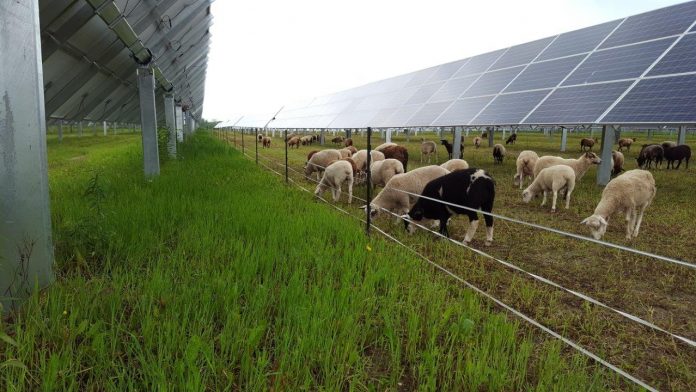
Solar grazing has been offered up time after time as the solution for keeping farm land in use, even as it is covered with solar panels.
The practice of having sheep graze under solar panels could be an opportunity for Ohio and Pennsylvania farmers. With acres of land fenced in with chain link fencing to protect stock from predators and abundant shade from the panels, the situation seems too good to be true for a shepherd.
It’s an opportunity that comes with many strings attached. Solar grazing is not as simple as throwing some sheep in a solar farm for the summer months.
“The one thing I stress to folks is professionalism is important here,” said Judy St. Leger, an American Solar Grazing Association board member. She spoke during a webinar panel discussing solar grazing held this past winter.
“When we started, I was like, ‘oh great, this is extra grazing space for my sheep.’ But also, it’s an extension to what the shepherd is doing. Going from raising sheep to providing a service, vegetation management.”
The basics
With solar grazing, sheep do what a team with lawn mowers and weed wackers would do. Every solar site needs vegetation management to keep the solar panels clear from tall grasses, weeds and vines.
While it seems like a good deal to let sheep graze on a solar farm for free, shepherds need to treat it like a business, because it is one.
“Whether it’s sheep or tractors, this is a service that the solar industry is conditioned to pay for,” said Tom Karas, of Minnesota Native Landscapes, a commercial landscaping company, just north of Minneapolis, that offers grazing services.
The price per acre varies widely, because the industry is still young. An economic model put together by the American Solar Grazing Association, the group that formed several years ago to promote the practice, calculated a shepherd could fetch $450 per acre for a vegetation management contract.
Sheep are the best grazing animals for the job, according to the American Solar Grazing Association. Sheep are small enough to go under and around panels, and not mischievous like goats, so they don’t chew on wires or jump on panels. Because of how sheep graze, they’re also ideal for clearing the areas around the thousands of posts that hold up the solar panels, Karas told Farm and Dairy.
Using animal landscapers is also a good look for solar companies. Lexie Haine, one of the founders of ASGA, said in the webinar that having solar grazers on a site can actually reduce risks for a company.
“We are there far more often and with a much more diligent eye than a regular operations person or landscaper,” she said. “We’re also there in a good neighborly way. If someone is walking down the road, we can be there to talk about the project. You can’t put a price on that.”
Going big
The solar industry in Ohio and Pennsylvania is still in its infancy, especially the large utility scale solar facilities covering hundreds of acres at a time. Hardin, the first utility scale solar farm in Ohio, became operational this past winter and covers about 1,115 acres of ground.
It’s one thing to graze a 20 or 40 acre site. That is something most graziers are probably familiar with on their home farms. Grazing something as large as a utility scale site presents opportunity and challenges.
Minnesota was an early adopter of commercial solar. The company has about 2,500 sheep that graze about 3,000 acres of land between dozens of sites, Karas said. Most of them are smaller sites, but one contract is 1,000 acres.
For a 10 acre parcel, they might put 300 sheep on it for three or four days, he said. The goal is to put out as many sheep as possible for the shortest duration of time to force the sheep to eat all the vegetation.
With the 1,000-acre site, it is broken down into smaller parcels that may or may not be contiguous, Karas said. With larger sites, they create smaller temporary paddocks within each larger section and do rotational grazing. Sometimes they have to truck in water, if there isn’t access on or near the site.
“On our large project, there are sheep on the property all year round through the grazing season,” he said.
There isn’t a rule of thumb for how many sheep per acre are needed to properly manage vegetation, due to all the variables at any given location, the time of year, the type of sheep, etc. ASGA has a formula, created by the U.S. Department of Agriculture Natural Resources Conservation Service – New York office, on its website to do the “sheep numbers.”
Sheep flocks in Ohio and Pennsylvania tend to be, on average, much smaller than that. A farmer interested in solar grazing needs to be able to buy in or grow the necessary number of sheep to properly manage a site. Karas suggested that maybe smaller farmers in Ohio and Pennsylvania could band together to offer their services for solar grazing. The need for solar grazing service is only going to grow in this region as solar projects continue to get built.
“These solar projects need to be managed for 25, 30 years, whether it’s through mechanical means or sheep,” he said. “We’re at the start of it. There’s room in this industry.”
(Reporter Rachel Wagoner can be contacted at 800-837-3419 or rachel@farmanddairy.com.)










